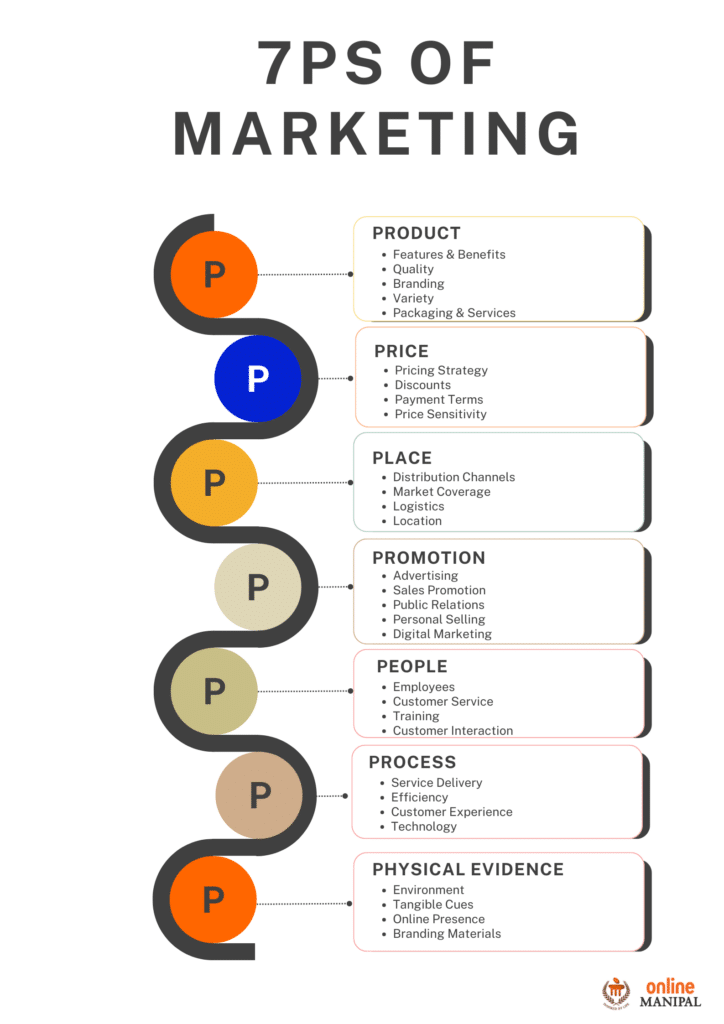Listen to this blog
The 7Ps of marketing, also known as the marketing mix, is a concept established by E. Jerome McCarthy in the 1960s. The 7Ps comprise Product, Price, Place, Promotion, People, Process, and Physical evidence.
A study by HubSpot found that businesses that use the 7Ps of marketing, be it digital marketing or traditional marketing ways are more likely to achieve their marketing goals.
New got newer: Experience the revamped Online Manipal website
What are the 7 Ps of marketing mix?
Product, Price Place, Promotion, People, Process, and Physical evidence are the 7 Ps of marketing mix. The same mix can also be considered for online marketing mix as well. Below we are discussing each P and how it contributes to effective marketing strategies.

1. Product
The first P, Product, refers to the goods or services that a business offers its customers. In other words, the product is the physical or intangible offering that a business sells to its customers. The Product element of the 7Ps covers product design, quality, features, and packaging. To execute successful marketing, businesses must understand their target market and ensure their products align accordingly.
Explore our online programs to become future-ready
View All CoursesAccording to the Content Marketing Institute, 73% of B2B marketers and 70% of B2C marketers use content marketing as part of their overall marketing strategy.
- Features and benefits: What the product offers and how it benefits the customer.
- Quality: The standard of the product.
- Branding: The identity and image of the product.
- Variety: Different versions or models available.
- Packaging: How the product is presented and protected.
- Services: Additional services like warranties or customer support.
2. Price
The Price element of the 7Ps covers the cost of goods or services. The price is the amount of money that customers pay for a product. It is important to set a price that is both competitive and profitable.
A study by McKinsey found that businesses that set prices based on value are more likely to be successful. Pricing strategies, such as discounts, bundling, and dynamic pricing, can significantly impact consumer behavior and shape purchase decisions. Different pricing strategies can also help businesses appeal to different demographics, such as premium pricing for luxury goods.
As per a study by Nielsen, 70% of consumers are more likely to buy a product if it is priced competitively. According to IBM Institute for Business Value research report, half of consumers are willing to pay a premium for sustainability. Furthermore, discounts and deals are considered essential factors in driving consumer behavior.
- Pricing Strategy: Methods like penetration pricing, skimming, or competitive pricing.
- Discounts and Allowances: Special offers, trade discounts, or seasonal pricing.
- Payment Terms: Options for payment, such as credit terms or installment plans.
- Price Sensitivity: How changes in price affect customer demand.
Check out Maslow’s Hierarchy of Needs
3. Place
The Place element of the 7Ps refers to the distribution channels of the business. It can be a physical store, an online store, or a combination of both. The goal of this P is to make the products easily accessible to customers.
As per a Deloitte study, shoppers are increasingly utilizing both online and offline shopping methods, often during the same shopping journey, in order to locate desired products at the optimal price point and utilizing the most convenient fulfillment method for their needs.
- Distribution Channels: How the product reaches the customer (e.g., retail, online).
- Market Coverage: The extent of market presence (intensive, selective, or exclusive distribution).
- Logistics: Transportation, warehousing, and inventory management.
- Location: Physical locations where the product is sold.
4. Promotion
The Promotion element of the 7Ps pertains to the communication strategies employed to make potential customers aware of and attracted to the product. The various marketing channels used for promotions include advertising, public relations, sales promotion, and other channels through different media. A successful promotion strategy must align with the target audience and ensure the message is simple, and the content is visually appealing.
A study by the Content Marketing Institute found that 80% of businesses use content marketing to promote their products and services. A study by HubSpot found that businesses that use social media marketing are more likely to achieve their marketing goals.
- Advertising: Paid promotions through various media channels.
- Sales promotion: Short-term incentives to boost sales (e.g., coupons, contests).
- Public relations: Managing the public image and media relations.
- Personal selling: Direct interaction between sales representatives and customers.
- Digital marketing: Online marketing strategies including social media, SEO, and email marketing.
5. People
The people are the employees, customers, and other stakeholders who interact with a business. It is important to create a positive and memorable experience for these people. For example, ensuring customer service representatives respond politely and efficiently impacts customer satisfaction levels.
A study conducted by Qualtrics and ServiceNow revealed that 80% of customers said they have switched brands because of poor customer experience. On treating internal people, an overwhelming 71% of employees in India are extremely or very concerned about being overlooked for career advancement opportunities as against 21% globally. This underscores the need to plan for robust and transparent talent recognition processes, finds a PwC study.
- Employees: Staff involved in delivering the product or service.
- Customer Service: Support provided to customers before, during, and after purchase.
- Training: Ensuring employees have the necessary skills and knowledge.
- Customer Interaction: How employees engage with customers.
6. Process
The Process element of the 7Ps refers to the procedures and steps involved in delivering a product or service to the end-user. It is important to streamline the process and make it as efficient as possible.
A study by the Aberdeen Group found that businesses that streamline their business processes are more likely to improve their customer satisfaction. In a Salesforce survey, 80% of customers say the experiences provided by a company are as important to them as its products and services. Moreover, a McKinsey study indicates that businesses that use data analytics to improve their business processes are more likely to be successful.
- Service delivery: Steps involved in delivering the product or service.
- Efficiency: Streamlining processes to reduce costs and improve quality.
- Customer experience: Ensuring a smooth and satisfactory experience for the customer.
- Technology: Tools and systems used to enhance processes.
7. Physical Evidence
Lastly, the Physical Evidence element of the 7Ps refers to the tangible aspects of a product, including packaging, branding, and more. Ensuring the tangible aspect of a product aligns with the customer’s perception of the brand is essential in setting the business apart from competitors.
As per National Retail Federation data, 72% of consumers are more likely to shop at a store that has a positive physical environment. An Epsilon research indicates 80% of consumers are more likely to make a purchase if brands offer them personalized experiences.
- Environment: The physical setting where the service is delivered.
- Tangible Cues: Physical items that support the service (e.g., brochures, uniforms).
- Online Presence: Website and digital footprint.
- Branding Materials: Logos, signage, and other visual elements.
How many Ps are there in marketing strategy?
The marketing mix is one of the marketing strategies organizations have traditionally used to sell their product. To lay the groundwork, the marketing mix is defined as a collection of marketing techniques that a firm uses to promote its brand or product in the marketplace.
The approach was typically structured around the four pillars of marketing: product, price, location, and promotion. However, as marketing became more sophisticated, so have the approaches. Later, it was expanded to 7Ps of online marketing strategy with the inclusion of People, Process, and Physical Evidence.
To drive marketing choices at every level, businesses materialize the aspects of the marketing mix. It assists them in:
- Recognizing its assets and mitigating its flaws
- Becoming more adaptive and competitive
- Improving departmental and partner collaboration
However, before you start using the 4Ps or 7Ps of marketing, you must first determine your target audience’s persona. Understanding who you’re selling to will help you determine the specifics of your marketing mix. Without it, you won’t be able to get started.
You may also like to know these concepts – 4 A’s of marketing and 4 Cs of marketing.
Importance of the 7Ps of marketing mix
The 7 Ps of marketing is a crucial concept for businesses to understand and implement in their marketing strategies. Each element plays an essential role in ensuring a successful marketing mix that aligns with the target audience and business goals. Listed below are the four important
- Understand the needs of their customers. The 7Ps help businesses to identify the needs of their target market and develop products and services that meet those needs. It can help businesses improve customer satisfaction levels, differentiate themselves from competitors, set realistic marketing goals, and maximize the effectiveness of their marketing budget.
- Develop a competitive strategy. The 7Ps help businesses to develop a competitive strategy by identifying the strengths and weaknesses of their competitors. Through this, organizations can determine areas that need improvement and optimize their marketing strategies to achieve better results. For example, a business might realize that their product pricing is higher than their competitors, leading them to reevaluate their pricing strategy to improve sales.
- Execute successful marketing campaigns. The 7Ps on online marketing help businesses to execute successful marketing campaigns by ensuring that all of the elements of the marketing mix are aligned. Incorporating relevant stats and figures into marketing campaigns can improve a business’s authority on the subject and improve search engine ranking. Utilizing keywords that potential customers might use when searching for products or services can also improve SEO ranking and increase visibility.
- Increase sales and profits. By using the 7Ps of marketing, businesses can increase sales and profits. Ensuring that the employees are trained in customer service and maintaining efficient processes can improve customer satisfaction levels and increase customer retention rates, that eventually turn into profits.
How to use the 7Ps of marketing mix
The 7Ps of marketing can be used to plan and execute marketing campaigns for any type of business. Here are some tips on how to use the 7Ps:
- Start with the product: The product is the foundation of your marketing strategy. Make sure that your product is well-designed, high-quality, and meets the needs of your target market.
- Set a competitive price: The price of your product should be competitive with other products in your market. You should also consider the value of your product when setting a price.
- Choose the right place: Where you sell your product will have a big impact on your sales. You need to choose the right channels to reach your target market.
- Promote your product: You need to let people know about your product if you want them to buy it. Use a variety of marketing channels to reach your target market.
- Focus on the people: The people who interact with your business are the most important factor in your success. Make sure that you provide them with a positive and memorable experience.
- Streamline the process: The process of buying and using your product should be as easy and efficient as possible. Make sure that your website is easy to navigate and that your customer service is responsive.
- Create physical evidence: The physical evidence of your business should create a positive impression on customers. This includes the physical environment, the branding, and the customer service.
Online MBA: Optimal choice for advanced marketing strategy
Online Manipal curates online MBA courses from top-notched institutions such as Manipal Academy of Higher Education (MAHE), and Manipal University Jaipur (MUJ). Marketing is one of the specializations in both these online postgraduate programs in management. These online MBAs in marketing help students learn all basic and advanced concepts in marketing.
Online MBA in Marketing curriculum at Manipal University Jaipur
| Semester 1 | Semester 2 | Semester 3 | Semester 4 |
| Management Process and Organizational Behavior | Production and Operations Management | Research Methodology | Strategic Management and Business Policy |
| Business Communication | Financial Management | Legal Aspects of Business | International Business |
| Statistics for Management | Marketing Management | Sales Distribution and Supply Chain Management | Management Business Leadership |
| Financial and Management Accounting | Management Information System | Consumer Behavior | Services Marketing and Customer Relationship Management |
| Managerial Economics | Operations Research | Retail Marketing | Advertising Management and Sales Promotion |
| Human Resource Management | Project Management | Marketing Research | E-Marketing |
| International Marketing |
Know more about the admission process to enroll in an online degree at MUJ.
Online MBA in Marketing curriculum at Manipal Academy of Higher Education
| Semester 1 | Semester 2 | Semester 3 | Semester 4 |
| Managing People & Organizations | Financial Management | Management Accounting | Entrepreneurship and Innovation* |
| Financial Reporting & Statement Analysis | Marketing Management | Legal Aspects of Business | Sustainability |
| Managerial Economics | Strategic Management | Consumer Behavior | Sales & Distribution Management |
| Business Statistics | IT for Business | Digital Marketing | Marketing Analytics |
| Business Communication | Business Leadership | Services Marketing and Customer Relationship Management | Integrated Marketing Communication |
| Research Methodology | Minor Project | Capstone Project |
Find out the admission process to enroll in an online MBA at MAHE.
Online MBA in Marketing curriculum at Sikkim Manipal University
| Semester 1 | Semester 2 | Semester 3 | Semester 4 |
| Principles of Management and Organizational Behavior | Quantitative Methods in Management | Project Management | Banking and Insurance Management |
| Marketing Management | Human Resource Management | Business Strategy | Market Research |
| Accounting for Managers | Financial Management | Consumer Behavior and Advertisement & Brand Management | Service Marketing & Global Marketing |
| Business Economics | Productions and Operations Management | Retail and Distribution Management and Supply Chain Management | Specialization II |
| Business Communication | Research Methodology and Statistical Techniques | Specialization II | Specialization II |
| Legal Aspects of Business | Global Economic Environment and Policy | Specialization II | Project Work |
| Computer Application in Management | Management Information Systems |
Learn more about online MBA marketing syllabus.
Mode of learning for online MBA
- Lectures, assignments, projects, and any other research work at Manipal University Jaipur are all done in English
- All programs are entirely accessible over the internet on an advanced learning management system (LMS)
- The LMS is used for teaching and assignment submission; credentials are given at the time of enrollment
- Students can access live webinars, doubt courses, guest sessions and reading materials at any time
- In their semester or final examinations, students must earn at least a 40% aggregate score
Read more on learning methods of online degree programs.
Conclusion
The 7 Ps of online marketing is an essential framework that can help businesses design effective marketing strategies and achieve their marketing goals. It provides businesses with a comprehensive approach to marketing, ensuring that each element aligns with the target audience and business goals. Understanding the importance of each element and incorporating relevant statistics and figures can improve authority on the subject, search engine ranking and achieve better marketing results. An online MBA in marketing will help acquire advanced skills in marketing to achieve professional success.











